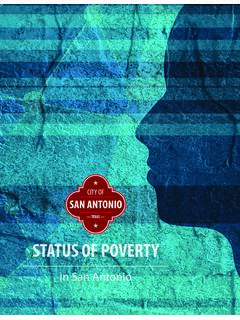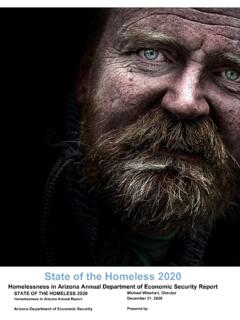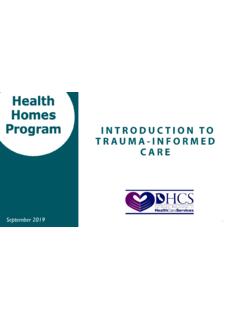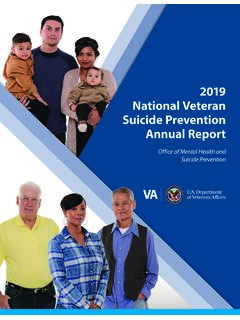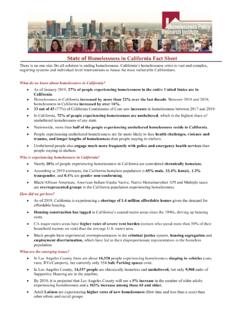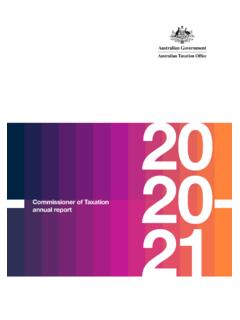Transcription of Homelessness Crisis
1 2021 MENINO SURVEY OF MAYORS 2021 MENINO SURVEY OF MAYORS SUPPORTED BYMayors and America sHomelessness CrisisBoston University Initiative on Cities1 Boston University Initiative on Cities 2021 MENINO SURVEY OF MAYORS: Mayors and America s Homelessness CrisisTABLE OF CONTENTSI ntroduction 2 Executive Summary 2 Methodology 3 Accountability and Capacity 5 Defining Success 10 Conclusion 12 Initiative on Cities Boston University 75 Bay State Road Boston, MA @BUonCities 617-358-8080 Levine Einstein Associate Professor, Political Science Boston University Charley E.
2 WillisonAssistant Professor, Public and Ecosystem HealthCornell University ContributorsStacy Fox Associate Director, Initiative on Cities Katharine LuskCo-Director, Initiative on Cities M. Glick Associate Professor, Political Science Maxwell Palmer Associate Professor, Political Science Nick HenningerLuisa Godinez PuigErin Tatz PhD Candidates, Political Science2 Boston University Initiative on Cities 2021 MENINO SURVEY OF MAYORS: Mayors and America s Homelessness Crisis INTRODUCTIONM illions of Americans experience Homelessness every year. Homelessness affects more Americans than opioid use disorders and overdose More Americans experience Homelessness than are diagnosed with cancer each The effects of Homelessness are comparably devastating: mortality rates for people who experience short-term Homelessness in a location such as temporary housing or a homeless shelter have mortality rates three times that of the general Yet despite this stark reality, we have very little systematic knowledge about the policy landscape shaping how we address this Crisis in the United of all sizes are disproportionately home to America s homeless Many have faced growing rates of Homelessness as a result of the COVID-19 Indeed, the Department of Housing and Urban Development has declared Homelessness a top policy priority in its House America Mayors are consequently at the frontlines of America s Homelessness Crisis .
3 They must weigh the needs of different civilian constituencies and manage complex bureaucracies responsible for cities service delivery and policy implementation. They are uniquely positioned to comment on the tensions and realities of Homelessness and responses to Homelessness in their jurisdictions. They can reveal the constraints facing policymakers seeking to change approaches to Homelessness in their communities. This year s Menino Survey explores how mayors are tackling this pressing national EXECUTIVE SUMMARYM ayors believe they are held accountable for addressing Homelessness in their cities, but feel they have little control. Almost three-quarters of mayors (73 percent) perceive themselves as being held accountable by residents for local Homelessness . Yet, only 19 percent believe that they have a lot of control over Homelessness in their city. Limited funding is a serious obstacle to effectively reducing local Homelessness . Over 60 percent of mayors say that limited funding is a significant barrier to addressing Homelessness more than 30 percentage points higher than the next closest option.
4 Majorities of mayors also see public opposition to new housing and shelters, limited human services, and a lack of coordination between different government and social service agencies as obstacles. 1 Lipari, Rachel N, and Eunice Park-Lee. 2019 . Key Substance Use and Mental Health Indicators in the United States: Results from the 2018 National Survey on Drug Use and Health. , pg. 2; Centers for Disease Control and Prevention. Drug Overdose Deaths. 2021. 2 National Cancer Institute. Cancer Statistics. 2021. 3 Roncarati, Jill S, Travis P Baggett, James J O Connell, Stephen W Hwang, E Francis Cook, Nancy Krieger, and Glorian Sorensen. 2018. Mortality Among Unsheltered Homeless Adults in Boston, Massachusetts, 2000-2009. JAMA Internal Medicine 178 (9): 1242 48. National Academies of Sciences Engineering and Medicine. 2018. Permanent Supportive Housing: Evaluating the Evidence for Improving Health Outcomes among People Experiencing Chronic Homelessness .
5 Washington : The National Academies Press. ; Willison, Charley E. 2021. Ungoverned and Out of Sight: Public Health and the Political Crisis of Homelessness in the United States. New York and London: Oxford University Press. Hoch, Charles, and Robert A. Slayton. 1989. New Homeless and Old: Community and the Skid Row Hotel. Temple University Press; Ensign, Josephine. 1990. Skid Road: On the Frontier of Health and Homelessness in an American City. Johns Hopkins University Department of Housing and Urban Development. 2021. The 2020 Annual Homeless Assessment report (AHAR) to Congress. Department of Housing and Urban Development. 2021. House America. This report is the second of three Menino Survey of Mayors reports based on interviews conducted during summer 2021. For related and forthcoming reports, please visit 3 Boston University Initiative on Cities 2021 MENINO SURVEY OF MAYORS: Mayors and America s Homelessness CrisisMayors see the local nonprofit community, Continuums of Care, and the police as shaping Homelessness policy.
6 More mayors highlight the role of the police as influencers than people at risk of or experiencing Homelessness . Mayors have limited staff capacity to address Homelessness . Almost one-third of cities (28 percent) have no staff exclusively devoted to serving people experiencing Homelessness . Thirty-eight percent of mayors house their staff dedicated to Homelessness in social services, while 22 percent place those staff in their police departments. Mayors have access to limited data on Homelessness . Ten percent of mayors say they do not have access to city-level data, while 38 percent only have access to annual data. Thirty-five percent of cities collect monthly data. A minority of mayors define policy success in terms of reducing Homelessness . Only 40 percent of mayors explicitly outline a policy goal of reducing Homelessness . When asked to define success, 42 percent of mayors highlight better housing, while 16 percent mention access to better social services.
7 Eleven percent emphasize minimizing what they perceive as the negative impacts of Homelessness on surrounding residents and invited mayors of all cities over 75,000 residents to participate in the Menino Survey of Mayors. Each mayor received an invitation at their official email account, as well as follow-up phone calls. We spoke with 126 mayors between June and August 2021 about a variety of topics including housing and Homelessness , the COVID-19 recovery, and closing the racial wealth gap. The overwhelming majority of interviews were conducted over the phone. Mayors responses and participation remain anonymous, to ensure they are able to speak freely about a wide range of issues. As Table 1 shows, the sample of participating cities closely mirrors the broader population on traits including size, racial demographics, housing prices, and geographic distribution. Table 1. Demographic Comparison of Sample Cities to All US Cities with Populations >75,000 Surveyed CitiesAll CitiesNumber of Cities126494 Average Population222,446223,766 Average Percent White53%48%Average Percent Black17%15%Average Percent Hispanic19%26%Average Percent Asian7%8%Average Median Housing Price$294,587$314,417 Region% of Sample% of CitiesMidwest21%16%Northeast12%9%South34 %35%West33%40%Source: 2019 American Community Survey (ACS), published by the US Census Boston University Initiative on Cities 2021 MENINO SURVEY OF MAYORS: Mayors and America s Homelessness Crisis Figure 1.
8 Demographics of Surveyed MayorsProfessional BackgroundHighest DegreeGenderPartyRaceOther 48%Law 30%Business 22%JD 33%Other 29%BA 23%MBA 10%PhD 5%White 79%Black 12%Latino 6%Other 2%Asian 1%Male 67%Female 33%Democrat 66%Republican 18%Other 16%5 Boston University Initiative on Cities 2021 MENINO SURVEY OF MAYORS: Mayors and America s Homelessness CrisisACCOUNTABILITY AND CAPACITY An overwhelming majority of mayors (73 percent) perceive themselves as being held highly accountable for addressing Homelessness in their communities. Mayors of high and low housing cost cities and across all regions of the country hold remarkably similar views. Strong majorities of mayors (69 percent of less expensive cities and 79 percent of more expensive cities) believe that their residents care about Homelessness , and use it when evaluating their local leadership. Figure 2. Accountability for Homelessness Figure 3. Control Over HomelessnessHow much do your residents hold you accountable How much control do you have over addressing for addressing Homelessness in your city?
9 Homelessness in your city?A greatdealA lotA moderateamountA littleNone at allA greatdealA lotA moderateamountA littleNone at all0%10%20%30%40%50%0%10%20%30%40%50%51% 22%17%9%5%14%42%34%4%2%Yet, mayors also feel they have relatively little control over addressing Homelessness in their city. Only 19 percent of mayors believe they have a lot of control over this serious challenge. Mayors in the Northeast are particularly pessimistic: only seven percent of them perceive themselves as having a lot of control over local Homelessness . Twenty-nine percent of their southern counterparts, in contrast, see themselves as having a fair amount of influence over local Homelessness . Still, across the country, mayors largely feel that Homelessness in their cities is outside of their control. Public opposition to homeless people, institutional obstacles, and inadequate funding all stymie mayors in their efforts to redress Homelessness . Indeed, over half of mayors cite public opposition to new housing or homeless shelters, limited funding, limited human and social services, and a lack of coordination between the government and different social service agencies as significant obstacles to addressing Homelessness in their cities.
10 There were some important differences along partisan lines: for example, Republican mayors are 19 percentage points more likely to say that public opposition hindered their ability to address Homelessness a lot. Sixty-five percent of Democratic mayors highlight limited human and social services as an important obstacle, compared with only 45 percent of Republicans. Fifty-five percent of Democratic mayors see evictions as a barrier to reducing Homelessness 30 percentage points more than their Republican counterparts. Perhaps most strikingly, 63 percent of Democratic mayors worry about a lack of coordination between different government and social service agencies, compared with only 28 percent of Republicans..63 percent of Democratic mayors worry about a lack of coordination between different government and social service agencies, compared with only 28 percent of Republicans. 6 Boston University Initiative on Cities 2021 MENINO SURVEY OF MAYORS: Mayors and America s Homelessness Crisis Limited funding, in particular, stood out as a substantial hindrance: over 60 percent of mayors used the most extreme option ( a lot ) to describe the extent to which it hindered their ability to address Homelessness over 30 percentage points higher than the next closest option.
